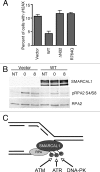SMARCAL1 and replication stress: an explanation for SIOD?
- PMID: 21327070
- PMCID: PMC3027029
- DOI: 10.4161/nucl.1.3.11739
SMARCAL1 and replication stress: an explanation for SIOD?
Abstract
The SNF2 family of ATPases acts in the context of chromatin to regulate transcription, replication, repair and recombination. Defects in SNF2 genes cause many human diseases. For example, mutations in SMARCAL1 (also named HARP) cause Schimke immuno-osseous dysplasia (SIOD); a multi-system disorder characterized by growth defects, immune deficiencies, renal failure and other complex phenotypes. Several groups including ours recently identified SMARCAL1 as a replication stress response protein. Importantly, SMARCAL1 localizes to stalled replication forks and this localization of SMARCAL1 activity prevents DNA damage accumulation during DNA replication. We determined that SIOD-related SMARCAL1 mutants could not prevent replication-associated DNA damage in cells in which endogenous SMARCAL1 was silenced, establishing the first link between SIOD and a defect in a specific biological activity. Here, we also report that cells from patients with SIOD exhibit elevated levels of DNA damage that can be rescued by re-introduction of wild-type SMARCAL1. Our data suggest that loss of SMARCAL1 function in patients may cause DNA replication-associated genome instability that contributes to the pleiotropic phenotypes of SIOD.
Keywords: ATM; ATR; DNA damage response; DNA replication; DNA-PK; HARP; RPA; SMARCAL1; checkpoint; replication fork.
Figures

References
-
- Hartwell LH, Kastan MB. Cell cycle control and cancer. Science. 1994;266:1821–1828. - PubMed
-
- Kastan MB, Bartek J. Cell cycle checkpoints and cancer. Nature. 2004;432:316–323. - PubMed
-
- McKinnon PJ, Caldecott KW. DNA strand break repair and human genetic disease. Annu Rev Genomics Hum Genet. 2007;8:37–55. - PubMed
-
- Barzilai A, Biton S, Shiloh Y. The role of the DNA damage response in neuronal development, organization and maintenance. DNA Repair. 2008;7:1010–1027. - PubMed
Publication types
MeSH terms
Substances
Supplementary concepts
Grants and funding
LinkOut - more resources
Full Text Sources
Medical
Research Materials
Miscellaneous
